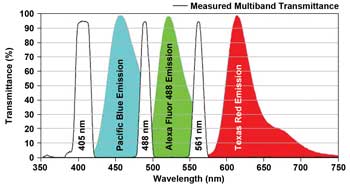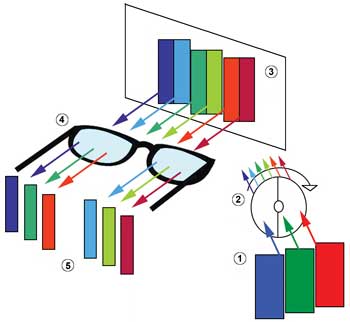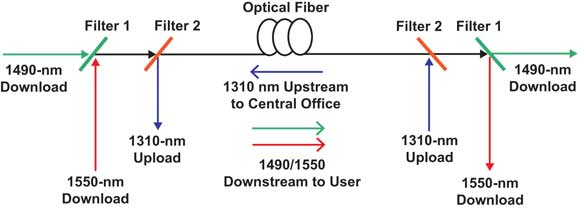Jason Palidwar and Catherine Aldous, Iridian Spectral Technologies
Whether used for imaging cells or astronomical bodies, multiband filters can improve signal-to-noise ratio while reducing cost, size, and setup and data-acquisition times in optical systems and instruments.
In the past, most optical filters had a single transmission or blocking band at a particular wavelength. But today, the demand for multiband filters is surging in many areas of application. The benefits of multiband dielectric filters go beyond well-known fluorescence applications to providing a new dimension to entertainment, studying the universe and connecting us to the Internet.
Today’s state-of-the-art optical filters owe much to the telecom boom at the turn of the millennium. The stringent demands on filter performance (both spectrally and from a reliability perspective) drove manufacturers to develop improved energetic sputtering processes and materials to enable controlled and repeatable deposition of dielectric filters with many hundreds of layers. To minimize any changes in performance both in the short-term operating environments and over the life of the optical network, these dense optical films also were designed to be resilient to the effects of temperature and humidity.
After the market for telecom filters evaporated in the dot-com crash of 2002, optical filter manufacturers looked to other markets where the enhanced performance could be an advantage. At the time, the optical filtering used in spectroscopy and microscopy instrumentation was dominated by “soft” coatings and holographic filters. The new sputtered dielectric films quickly proved their worth by providing previously unachievable performance (transmission and blocking levels, edge steepness and ripple). The frequent requirement to replace the soft-coated or holographic filters as they wore out also was eliminated by these new thin films. They found a home and flourished there, dominating the marketplace and facilitating new spectroscopic analysis capabilities.
In the field of fluorescence imaging, the proliferation of multiple fluorophores began to enable users to label and analyze multiple objects or events in the same specimen. The filter cubes of the time consisted of sets of excitation, dichroic and emission filters that were switched in and out of the light path according to the specific fluorophore under interrogation. The imaging was time-consuming, greatly limiting the ability to analyze live or time-sensitive specimens.

Figure 1. Transmittance of multiband emission filter measured at 46° (s-polarization). The emissions of common fluorophores are shown. Images courtesy of Iridian Spectral Technologies.
To address both these needs, multiband filters were developed that provide the ability to transmit, reflect, and block excitation and emission bands for multiple different wavelengths within a single optical filter (Figure 1). This development in optical filters greatly improved ease of use and data collection and led to the ability to study cells and their development or death in real time (critical in the field of cancer research, among other disciplines).
But that’s just the beginning of the story of multiband filters. Although this new development revolutionized live-cell and other fluorescence imaging modalities, the approach also found its way into several other completely different applications: from 3-D cinema to astronomy, even to finding new life back in the telecom cradle.
Coming to a theater near you
The recent boom in 3-D movies has been driven by the evolution from the headache-inducing red-blue glasses of the past to new technologies leveraging the properties of multiband dielectric filters. All 3-D entertainment systems operate by projecting two physically offset images (one image intended for viewing by each eye) that produce the illusion of depth. To create the best color contrast while minimizing crosstalk, companies such as Infitec, Dolby and Panavision have employed a wavelength-multiplex visualization approach to producing and viewing these two images.
Viewing separate wavelengths of light with each eye was the basis for the red-blue 3-D anaglyph glasses – but by simply separating the visible spectrum into two bands, each eye perceived radically different color palettes. The complementary multiband filters in the two lenses enable both eyes to view a spectrum of red, green and blue wavelength components, representing the three spectral ranges to which the eyes’ receptors are sensitive (Figure 2). This approach provides a balanced color palette and eliminates ghosting caused by images reaching the wrong eye.

Figure 2. (1) Red, green and blue (RGB) images are projected toward the screen; (2) a rotating filter wheel chops the RGB into two colors for each band; (3) the projection on the screen consists of two offset images, each with different sets of RGB colors; (4) the different lenses in the 3-D glasses allow only one set of RGB colors to reach each eye; (5) the viewer perceives a 3-D RGB image.
The robust nature of these dielectric multiband 3-D glasses, once again leveraging the telecom heritage, allows them to be cleaned and reused rather than discarded after a single use, as is the case with most polarization-based glasses. This provides a cost-per-use advantage, as these glasses can withstand hundreds of repeat uses. Aside from the cost benefit, the environmental advantages of these glasses include reduced transport costs and fuel usage (each new movie needn’t be accompanied by a truckload of glasses); they also preclude the need for landfill disposal of used glasses.
Some of these 3-D cinema systems employ a filter wheel, with one half-coated to correspond to one eye and the other corresponding to the complementary multiband spectra, rotating in front of the movie projector to create these two images on-screen. This enables the use of a white light source to create the two multiband color images for each eye without the need for dedicated light sources.
To infinity and beyond
Astronomical cameras can benefit from multiband filters in several ways. In ground-based applications, background from OH emission lines in the atmosphere can be a problem. These lines are concentrated in several wavelength regions, such as in the J-band, and multiband filters can reject these unwanted regions while accepting the light in between.
There are also several objects (Type Ia supernovae, Type T brown dwarfs, etc.) that can be recognized by characteristic spectra. Using a multiband filter with a transmission curve corresponding to a characteristic spectrum, an object of interest can be identified or sought. At Johns Hopkins University, Daniel Scolnic, Nobel Prize winner Adam Riess and Mark Huber used a multiband filter to find Type Ia supernovae and their redshifts.1 Among the advantages, they describe this as a speedier – up to 30 times faster than long-slit spectroscopy methods – approach, and more economical and reliable as well.
Switching between single-bandpass filters is not always easy – some astronomical cameras have filters that are sealed in a cryostat or that operate in space. Multiband filters offer a great advantage in situations where such adjustments are extremely inconvenient.
Party like it’s 1999
How fast is fast enough: 3G/4G, WiMax, LTE? The demand for ever-faster wireless networks is fueling a new telecom arms race to provide the maximum bandwidths of voice, video and data to users everywhere, on demand, with increases in network speed. This opens the door to new or improved applications requiring faster access to even more bandwidth.
End users experience only the wireless transport of information to and from mobile devices. However, this massive amount of information is transported largely along fiber optic telecom backbones between central base stations and various passive cells that pick up and radiate wireless digital signals. As is the case with fiber-to-the-home (FTTH) telecommunications systems, these wireless networks have adopted a triple-band architecture: Wavelengths around 1310 nm transport data upstream to the network with wavelengths from 1450 to 1490 nm transporting data (Internet and phone) and 1510 to 1570 nm transporting digital video downstream to users. The upstream and downstream data transport is accomplished with multiplexing optical filters (Figure 3).

Figure 3. The 1310/1490/1550 filters are applied in FTTx single-fiber bidirection- and multiple-wavelength systems to manage the video, voice and data upstream or downstream transmission (Filter #1 – 1490T/1550R; Filter #2 – 1490&1550T/1310R).
Increasing demands on networks require more signals to more users, with more content leading to more filter-based optical components. Use of dual-band optical filters in these next-gen telecom applications halves the number of optical components required. By allowing easier and cheaper provisioning of the wireless networks with these three telecom services, multiband filters reduce costs and module sizes for systems manufacturers.
The next chapters
New applications for multiband filters are continuing to emerge. Multiband dielectric filters are being used to provide enhanced image contrast for 3-D endoscopic imaging applications. Simply using one multiband filter can improve image contrast, giving a better view of surface texture, and improving diagnosis and differentiation of certain types of tissue.2 Taking this a step further, Ronald Korniski presents the idea of using complementary multiband filters to provide a 3-D endoscopic image.3 By providing a sense of depth and eliminating the need for additional imaging tools, this gives a significant advantage to surgery guided by an endoscope.
The hazards that handheld laser pointers pose to pilots, train conductors and law enforcement personnel have also presented a new need to be addressed by multiband filters. Glasses with notches corresponding to multiple laser pointer wavelengths can be designed to provide protection from sudden vision loss or distraction while maintaining high transmission.
This is not the end of the story of multiband filters. Multiband filter technology has enabled optical products and components to be more compact and economical while providing improved functionality in these (and other) new applications. The benefits of multiband dielectric filters will continue to open doors in areas beyond bioanalysis, entertainment, astronomy and telecom.
Meet the authors
Jason Palidwar is an account manager at Iridian Spectral Technologies in Ottawa, Ontario, Canada; email: [email protected]. Catherine Aldous is a sales engineer at Iridian; email: [email protected].
References
D.M. Scolnic et al (October 2009). Optical cross correlation filters: an economical approach for identifying SNE Ia and estimating their redshifts. Astrophys J, pp. 94-107.
ASGE Technology Committee et al (April 2008). Narrow band imaging and multiband imaging. Gastrointest Endosc, pp. 581-589.
R. Korniski et al (September 2011). 3D imaging with a single-aperture 3-mm objective lens: concept, fabrication, and test. Proc SPIE, Vol. 8129, 812904.